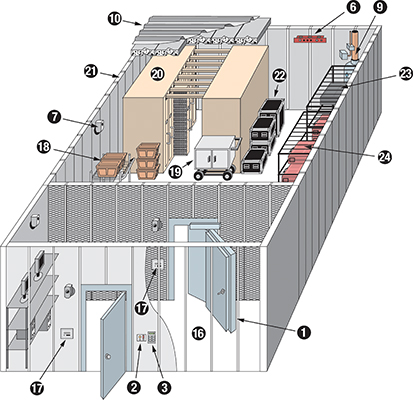Designing a fireproof vault room requires careful consideration of various factors to ensure that it provides optimal protection for valuable assets and documents. The design should take into account fire resistance, security, accessibility, and functionality. Here are key considerations for designing a fireproof vault room:
1. Fire Resistance Rating:
– Determine the required fire resistance rating based on the nature of the items to be stored and the duration of fire protection needed. Fireproof vaults are typically rated for specific time periods, such as 1 hour, 2 hours, or more.
2. Vault Size and Capacity:
– Assess the volume of items to be stored and determine the size and capacity of the vault room accordingly. Ensure that there is sufficient space to accommodate current and future storage needs.
3. Vault Location:
– Choose an appropriate location within the building for the vault room. It should be easily accessible to authorized personnel but not easily visible or accessible to unauthorized individuals.
4. Structural Materials:
– Select fire-resistant construction materials for the walls, ceiling, and floor of the vault room. Common materials include reinforced concrete, fire-rated drywall, and steel.
5. Vault Door:
– Choose a high-quality, fire-rated vault door with a fire resistance rating that matches the overall rating of the vault room. The door should have secure locking mechanisms and be equipped with fire-resistant seals.
6. Access Control:
– Implement robust access control systems, including electronic locks, biometric authentication, and security alarms. Restrict access to authorized personnel only and maintain a log of entries.
7. Surveillance and Monitoring:
– Install surveillance cameras and monitoring systems to record activities inside and outside the vault room. Alarms should be triggered in case of unauthorized access or security breaches.
8. Environmental Controls:
– Consider environmental factors such as temperature and humidity control, especially if the vault room will house sensitive materials like archival documents or electronic equipment.
9. Ventilation:
– Ensure proper ventilation to prevent the buildup of heat and smoke in the event of a fire. Ventilation systems should maintain a relatively clean and cool environment.
10. Fire Suppression Systems:
– Install automatic fire suppression systems, such as sprinklers or gas-based systems, to detect and extinguish fires or suppress them until firefighters arrive.
11. Fireproof Storage Solutions:
– Choose fireproof safes, cabinets, shelving, and racks for storing items within the vault. Ensure that these storage solutions have appropriate fire resistance ratings.
12. Emergency Lighting:
– Install emergency lighting to provide visibility in case of power outages during a fire or other emergencies.
13. Accessibility:
– Design the vault room to be accessible to authorized personnel with consideration for the use of mobility aids if needed.
14. Compliance with Regulations:
– Ensure that the vault room design complies with local building codes, industry regulations, and fire safety standards.
15. Security Protocols:
– Establish security protocols and procedures for the vault room, including key management, access logs, and response plans for security incidents.
16. Maintenance Plan:
– Develop a maintenance plan to regularly inspect and maintain all components of the vault room, including fireproofing materials, locking mechanisms, and security systems.
17. Training and Access Authorization:
– Provide training to authorized personnel on security protocols, access procedures, and emergency response. Maintain a system for granting and revoking access permissions.
18. Budget Considerations:
– Consider budget constraints when designing the vault room, and prioritize essential security and fire protection features based on available resources.
Designing a fireproof vault room is a complex process that requires expertise in security and fire protection. Engaging with professionals in these fields is highly recommended to ensure that the design meets the specific needs of your organization and provides the highest level of protection for your valuable assets and documents.
FIRELOCK® provides these articles for information purposes only. We do not necessarily provide all products and services mentioned; they are for comparison purposes only. Always contact a professional about non-FIRELOCK® products and services mentioned.
About FIRELOCK®
Since 1982, FIRELOCK® has been the world’s leading manufacturer of media-rated modular vault chambers. Unlike poured-in-place concrete vaults, FIRELOCK® vaults are constructed from individual panels, filled with a heat-resistant ceramic material, and they are lightweight, movable, and expandable. When combined with current high-density storage systems, FIRELOCK® vaults offer extremely high space efficiency at a considerable cost advantage per cubic foot of storage. The value of assets stored in FIRELOCK® vaults today reaches hundreds of billions of dollars and ranges from priceless animation cells and World Wrestling Entertainment videos to pharmaceutical research records and U.S. Department of Education student loan information.
With a FIRELOCK® vault, you invest in the highest-performing vault on the market today to ensure the protection of your most vital records and irreplaceable items. You gain the ability to store microfilm, computer media, file servers, and paper in one location, as well as the peace of mind that comes from knowing that all the environmental- and fire-protection elements are in place.FIRELOCK® has been in business since 1982, and we have installed over 2000 vaults around the world. Because of this broad experience, we know how to build a vault that will provide you with maximum protection today and the flexibility to grow with you into the future.
